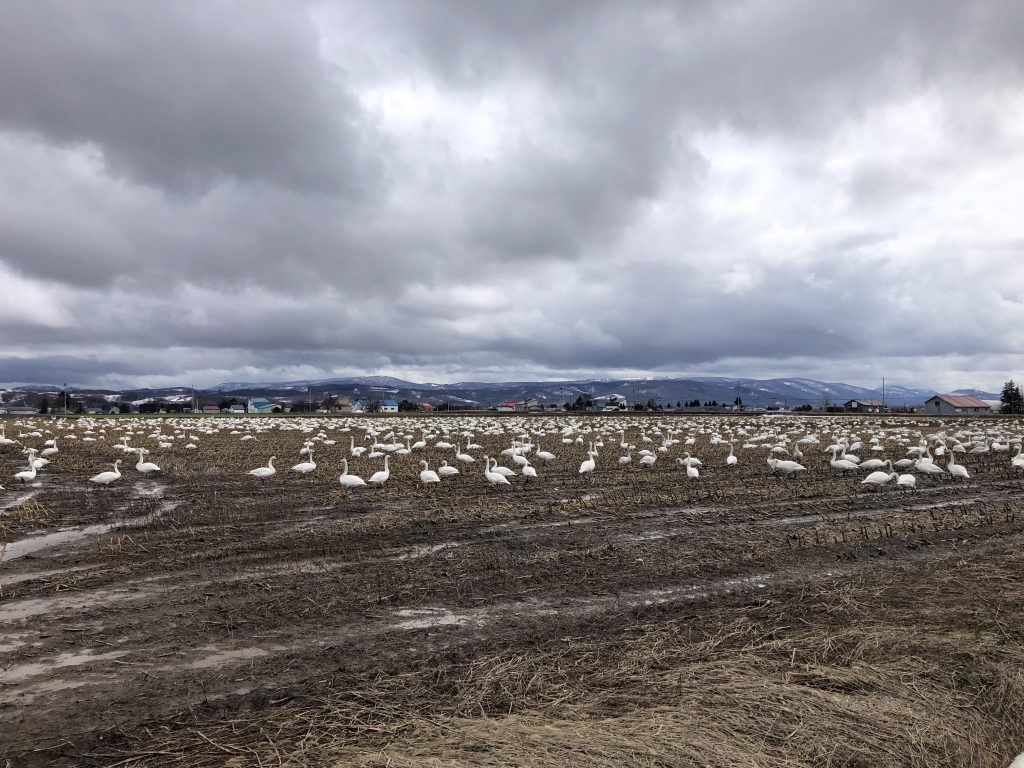剣淵町に白鳥が来た

剣淵町の我が家の家の上を白鳥が通ります。
我が家から400mぐらいの場所にある、トウモロコシ畑跡地が、渡来する白鳥の野営地/休憩所になっています。こんなことは、私の60年余の人生にはありませんでした。とても不思議です。
白鳥は、晩秋、雪が降る前にロシアから日本に飛んで来ます。秋は剣淵町の上空を通るだけです。町内で、一部、餌付けをしている人がおり、その田んぼ跡地には短期間滞在します。
春にはロシアに戻ります。ロシア/ユーラシア大陸のどこかは分かりませんが、見ていると東の方に飛んでいきます。カムチャッカ半島の方角ではないかと勝手に想像しています。
剣淵町では、農作物の作付前に、土地はいくらでもありますが、その中で野営地に選ばれる土地の特徴はいくつかあります。
全くの平地ではなく、畝がある。
雪解け水が少し残っている。
周囲に障害物(家屋、立木、電線、電柱等)がないこと
家屋から300m以上離れていること。
彼らは、朝6時から7時30分頃にかけて東からやってきます。多くが5~15羽程度でV字編隊を組んで飛んで来ます。中には、1羽、2羽で来るものもいます。そして、少し旋回してから畑に降ります。白鳥は大きな鳥です。頭から足まで伸ばすと1.2m程度、翼長は左右で2m程度です。このような鳥は、降りるところを確かめ、飛行機のように滑空して降りてきます。それゆえ、近くに立木、塔などの障害がある場所には降りられません。山間部、傾斜地も無理でしょう。野生ですから警戒心も強く、人家から最低でも300m離れた場所に滞在しています。近くで見ることはできますが、最低でも人間から約100m距離を保ちます。彼らの行動を見ていると、朝5時から8時くらい、夕方4時から6時くらいの間、とても大きな声で鳴きます。仲間内を確かめているのか、あるいは番いを求めているのか、良く分かりません。見ていると、2羽で飛んでいるものも少なからずいます。おそらく「デート」ではないかと思います。日中はその多くが寝ています。起きて、地面に溜まった水を飲んでいるものいます。食事はしていないようです。彼らの嘴の特徴から、水に浮いているもの、あるいは水中の魚しか食べられないでしょう。そして夕方になると飛び立ち、去ります。朝は新しいものが来ます。滞在期間は1、2日ではないかと推察します。
この野営地に白鳥が集まりだしたのは4月に入ってからです。最初は50~60羽でした。しかし、4月8日に見に行った時には約1,000羽いました。(映像をご覧ください。)おそらく、白鳥がロシアに向けて移動するのは夕方から夜だと思います。日中、日光に照らされると体温が上がり、体力が奪われるのでしょう。おそらく、本能的にある場所を目指しているので、夜、地形が見えずとも良いのでしょう。剣淵町は、北海道の中で、東西でみると真ん中です。東西は山ですが、その間には幅約6km、南北約15㎞の平地があります。白鳥は、そのような場所を見つけ、渡り歩いているのだと思います。
地球温暖化は進んでいると思いますが、生き物たちは対応しています。白鳥以外にも町内には私が子供のころにはいなかった鳥たちがいます。今回の白鳥の渡来が何によるものかは分かりませんが、変化する自然、そしてそれに適応しようとする生き物の強さを感じさせる出来事です。
Swans pass over my house located in Kembuchi Town, Hokkaido.
About 400 meters apart from my house, a former cornfield is used as a camp/resting place for migrating swans. I have never seen anything like this in my 60 plus years of life. It’s very mysterious. Swans fly from Russia to Japan in late autumn, before the snow falls. In autumn, they just pass over Kembuchi. In the town, there are some people who feed them, and swans stay for a short time in former rice fields.
Swans will return to Russia in the spring. I don’t know where it is in the Russian/Eurasian Continent, but when I look at swans, they fly to the east. I imagine that it’s in the direction of the Kamchatka Peninsula.
In Kembuchi, there is a lot of land to be used for planting of crops, but there are several characteristics of the land that swans select for the camp. It is not flat, but has ridges. There is some water left from the melted snow. There should be no obstacles (houses, trees, electric wires, poles, etc.) in the surrounding area. 300m or more away from the house.
They come from the east around 6:00-7:30 in the morning. Most of them fly in a V-shaped formation with about 5 to 15 birds. Some come by itself or by two birds. Then make a few turns and descend into the field. Swans are big birds. It is about 1.2m when extended from head to foot, and the wingspan is about 2m from side to side. Such birds make sure they can land on to the land and then glide down like an airplane. Therefore, it is not possible to get off where there are obstacles nearby. Mountainous areas and sloping areas are also impossible. Because they are wild, they are highly cautious and stay at least 300 meters away from human appearance. We can see them relatively close, but swans maintain a minimum distance of approximately 100m from humans. Observing their behavior, they cry very loudly between 5:00 and 8:00 in the morning and between 4:00 and 6:00 in the afternoon. I’m not sure if they’re checking on their friends or if they’re looking for a mate. When I look at it, there are quite a few that are flying by a couple. I think it’s probably a “date”. Most of them sleep during the daytime. Some are awake and drinking water t on the ground. It doesn’t look like eating something. Because of their beak characteristics, they will only eat things that float on the water or fish in the water. Then in the evening it takes off and leaves. New swans come in the morning. I guess the length of stay is one to two days.
It wasn’t until April that the swans began to gather in this camp. At first it was 50 to 60 birds. However, when I went to see them on April 8, there were about 1,000 birds. (See video.) I think swans are probably migrating towards Russia in the evening or at night. During the daytime, if they are exposed to sunlight, their body temperature will rise, and your physical strength will be taken. Perhaps they are instinctively aiming for a certain place, so they don’t need to be able to see the terrain at night. Kembuchi is at the center of Hokkaido when viewed from east to west. There are mountains in the east and west, but in between there is a plain about 6 km wide and about 15 km north to south. I think swans find such places and migrate.
I think that global warming is progressing, but living things are coping with it. In addition to swans, there are other birds in the town that weren’t there when I was a child. I don’t know what caused the migration of swans this time, but it is an event that makes me feel the strength of the changing nature and the creatures trying to adapt to it.

